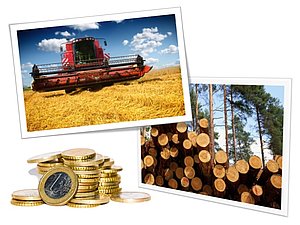Basic agricultural and basic forestry activities
Event description

Owners and actual users of agricultural and forest land have to pay income tax from basic agricultural and basic forestry activities.
What are the possible forms of tax treatment of income from agricultural and forestry activities?
The tax base for income tax on basic agricultural and basic forestry activities is determined on a flat rate basis, on the basis of cadastral income and lump sum assessment of income per beehive. Providers of the basic agricultural and the basic forestry activities determine the tax base for their complementary agricultural and basic forestry activities in their tax returns on the basis of their actual income and actual expenses or on the basis of their actual and flat rate expenses).
What activities may be performed in the framework of the basic agricultural and basic forestry activities?
Agricultural and forestry activities can be deemed as basic agricultural and as basic forestry activities if they are carried out on agricultural or on forest land that is properly registered in the land cadastre by actual type of land use.
The basic agricultural activity is considered to be crop and grass production on agricultural land, the production of different types of fruit on land registered in the land cadastre as intensive orchard, hop growing on land registered as a hop growing area, the production of grapes on land registered as vineyards, olives and olive oil production on land registered as an olive grove. Livestock production is categorised as the basic agricultural activity, but only to the extent of breeding of animals for live sale (to be slaughtered, for breeding or further breeding in the framework of agricultural activity) and provided that the bulk of the feed for these animals is produced on the land used by an agricultural household. Basic forestry activity is considered to include the production of raw wood categories, such as logs, mining timber, poles, firewood and other wood residues suitable for energy production. Beekeeping using duly registered beehives can also be considered to be a part of the basic agricultural activity. With that in mind, beekeeping is considered to be an activity consisting of the production of honey, honeycomb, royal jelly, pollen, propolis, wax, bee poison and queen bees.
Wine production from own grown grapes and olive oil production from own grown olives, which are classified as processing activities, may be exceptionally carried out as part of the basic agricultural activity.
What should be done by the users of agricultural and forest land who are not its owners?
If agricultural or forest land is actually used by a person who is a member of a farm household in which no member has no right to use this land on the basis of the legal title in the land register and the land cadastre, this land is attributed for tax purposes to the actual user of the land on the basis of a report to the tax authority by the actual user of agricultural and forest land.
The cultivation of special crops in the framework of the basic agricultural and basic forestry activities
The system of cadastral income also includes the intensive cultivation of special crops (vegetable crops and herbs, strawberries, artichokes and asparagus in fields, the production of seeds and seedlings of arable crops, vegetable crops and herbs in open air or in tunnels and snail breeding in the fields) if the taxable person is registered for this kind of production at the Agency of the Republic of Slovenia for Agricultural Markets and Rural Development.
What should be done by the users of agricultural and forest land outside the Republic of Slovenia?
Agricultural and forest production on land situated outside the Republic of Slovenia is classified as the basic agricultural and basic forestry activities. Members of agricultural households must report to the tax authority the area of agricultural and forest land that they use outside the Republic of Slovenia.
Claiming tax relief for investment in basic agricultural and basic forestry activities
Taxable persons engaged in basic agricultural and in basic forest activity and who determine their tax base for income from these activities on a flat-rate basis may claim a 40% tax relief on investment in capital assets and equipment necessary for the performance of these activities in an agricultural household.
The small scale of the first-stage processing of own agricultural and forestry products
Certain small-scale first-stage processing activities of own agricultural and forestry products that are considered to be products of basic agricultural and basic forestry activities that are otherwise part of complementary agricultural activities may be treated as small-scale activities, and income from these activities may be deemed as income from basic agricultural forestry activities that is exempt from personal income tax.



